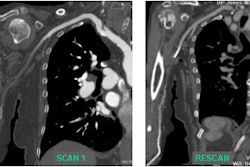In the first multimodality assessment of a recently approved wireless capsule endoscopy (CE) system, the technique detected several types of pathologies better than CT and barium enema in patients with suspected small-bowel pathologies who had no evidence of stricture.
"Fluoroscopic small-bowel imaging is challenging because of the complex and lengthy small-bowel anatomy," wrote Dr. Amy Hara, Dr. Jonathan Leighton, Dr. Virinder Sharma, and Dr. David Fletcher in the January issue of Radiology. "Until recently, the small bowel was the only part of the alimentary tract not completely accessible with endoscopy, and only indirect evaluation was possible by using small-bowel follow-through (SBFT) barium examination or enteroclysis. Both of these radiologic techniques, however, are suboptimal: Varying examination techniques hamper the SBFT...(small-bowel follow-through examination with barium), and patient discomfort and high radiation dose limit enteroclysis" (Radiology, January 2004, Vol. 230:1, pp. 260-265).
The researchers, from the Mayo Clinic in Scottsdale, AZ, examined 52 patients (31 men, and 21 women, mean ages 63 and 64), 43 of whom had gastrointestinal bleeding of unknown origin that persisted or recurred, with negative findings on colonoscopy or upper endoscopy.
Forty-two patients also underwent 36 small-bowel single-contrast barium enema exams (SBFT) using a 50% we/vol barium sulfate suspension, and four patients underwent enteroclysis.
Sixteen patients had contrast-enhanced CT within six months of CE. Following IV administration of 300 mg of 0.45 ml/kg contrast material (70-second delay) (Omnipaque, Amersham Health, Little Chalfont, U.K.), patients underwent CT imaging on a four-row scanner (Somatom Plus 4 Volume Zoom, Siemens Medical Solutions, Malvern, PA) using standard 5-mm section thickness. A special small-bowel protocol (3-mm slice thickness, 2,000 mL of water as contrast) was used in four patients, the authors wrote.
The CE system (M2A Diagnostic Imaging System, Given Imaging Systems, Yoqneam, Israel) was ingested after an eight-hour fast. The 2.6 x 1.1-cm system contains a miniature video camera, a light source, batteries, and a radio transmitter. Radiotelemetry was used to transmit images to leads taped to the body, and to a portable recorder, from which the images were subsequently downloaded to a dedicated workstation.
According to the results in 42 patients, CE found 11 cases of angioectasia, eight ulcers, and three masses. Nineteen of 40 (48%) CE exams (P<0.001) were positive (four patients had more than one finding).
CT had small-bowel findings in 4/19 (21%) of patients; however, it did not detect a single small-bowel mass that was not also seen in CE. Three patients with inflammatory small-bowel disease were correctly identified at both CE and CT using the special small-bowel CT imaging protocol, the authors wrote.
Barium enema (40/42 patients) was positive in only one patient (3%), who had an ulceration of the terminal ilium, which was also identified at CT. This patient also had an enterocolic fistula, which was not seen in CE.
There were five surgically confirmed small-bowel masses. Three were detected at CE, including a 1.7-cm ileal carcinoid tumor, an intussicepted small-bowel loop without an associated lesion, and a 1.5-cm lymphangioma. All three were negative at barium enema. One mass was missed at CE due to retained food, but surgery subsequently identified a stromal tumor and a carcinoid tumor in this patient. One of these masses was identified at CT. Still, CE missed two jejunal tumors and a coloenteric fistula. All four enteroclysis exams were negative, the group reported.
"The main advantage of CE is the ability to provide a more complete endoscopic evaluation of the small bowel than has previously been available," Hara and colleagues wrote. "Other advantages include relatively low risk for the patient, absence of radiation, and minimal patient discomfort. It is also less likely operator-dependent compared with the (barium enema) examination. Vascular abnormalities, such as cases of angioectasia, are a common cause of gastrointestinal bleeding and are also detected most reliably with direct visualization."
The barium enema exam is the most commonly used for small-bowel imaging due to its ease of administration; however, its accuracy varies widely depending on technique, the group stated. In any case, the BE results were poor in this study, demonstrating disease in only one patient, compared to CE's 19 patients.
"In addition, enteroclysis was rarely performed in these patients, although it is often the recommended examination when small-bowel bleeding is suspected," the authors wrote. "While it is possible that more findings would have been discovered with this technique, CE still demonstrated an ulcer in patients with negative findings at enteroclysis.... Finally, CE was not performed in patients with a stricture found at (barium enema) examination, thus biasing the study against patients with advanced small-bowel disease. If these patients with more severe small-bowel disease were included, it is likely that more findings would have been demonstrated with the (barium enema) examination."
The preliminary comparison of barium enema, enteroclysis, CT and CE showed that in patients without strictures, CE found more cases of small-bowel disease than barium enema and CT, which unexpectedly missed some vascular abnormalities. However, current CE technology cannot measure polyps and ulcers. CE is likely to play an important future role in small-bowel imaging, but further barium and CT studies are needed, the authors concluded.
By Eric BarnesAuntMinnie.com staff writer
January 14, 2004
Related Reading
Lower cardiovascular risk makes virtual colonoscopy safer, study finds, December 31, 2003
Given Imaging gets reimbursement for Crohn’s disease, December 16, 2003
Magnification endoscopy may improve assessment of colon cancer risk, August 6, 2003
Endoscope guides precise Botox delivery for anal fissure treatment, June 18, 2003
Copyright © 2004 AuntMinnie.com




















